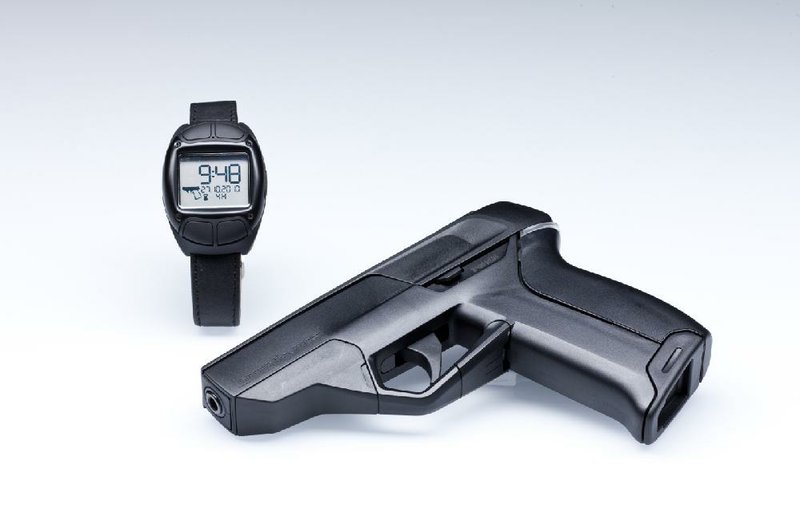One of California’s largest firearm stores recently added a peculiar new gun to its shelves that requires an accessory: a black waterproof watch.
The watch’s primary purpose is not to provide accurate time, which it does. The watch makes the gun think.
Electronic chips inside the gun and watch communicate with each other. If the watch is within close reach of the gun, a light on the grip turns green. Fire away. No watch means no green light. The gun becomes a paperweight.
A dream of gun-control advocates for decades, the Armatix iP1 is believed to be the first smart gun being sold to the public.
Its introduction is seen as a landmark to reduce gun violence, suicides and accidental shootings. Proponents compare smart guns with automobile air bags - a transformative add-on that gun owners will demand. Gun-rights advocates are already balking, wondering what happens if the technology fails when an intruder breaks in.
James Mitchell, the “extremely pro-gun” owner of the Oak Tree Gun Club in Newhill, Calif., isn’t one of the skeptics. His club’s firearms shop is the only outlet in the country selling the iP1.
“It could revolutionize the gun industry,” Mitchell said.
The implications for the iP1’s introduction are potentially enormous, both politically and economically.
Lawmakers around the country have been intrigued by the possibilities. New Jersey passed a contested law in 2002 requiring that only smart guns be sold in the state within three years of a smart gun being sold anywhere in the country. A similar measure made it through the California Senate last year, and at the federal level, U.S. Rep. John Tierney, D-Mass., has introduced similar legislation.
Although National Rifle Association officials did not respond to requests for comment about smart-gun technology, the group fiercely opposes “government mandates that require the use of expensive, unreliable features, such as grips that would read your fingerprints before the gun will fire,” according to the website of its lobbying arm, the Institute for Legislative Action. “And NRA recognizes that the ‘smart guns’ issue clearly has the potential to mesh with the anti-gunner’s agenda, opening the door to a ban on all guns that do not possess the government-required technology.”
The arrival of smart-gun technology comes amid a flurry of interest in the concept from investors who think the country - after the killings at Sandy Hook Elementary School and the legislative battles that followed - is ready for new, innovative gun-control ideas. Last month, Ron Conway, a Silicon Valley titan and early investor in Google and Facebook, launched a $1 million Xprizelike contest for smart-gun technology.
“We need the iPhone of guns,” said Conway, noting how the new iPhone 5s can be unlocked quickly with a fingerprint. “The entrepreneur who does this right could be the Mark Zuckerberg of guns. Then the venture capitalists like me will dive in, give them capital, and we will build a multibillion-dollar gun company that makes safe, smart guns.”
The cost of such weapons can be high. Armatix’s iP1, a .22-caliber pistol, is $1,399 - plus $399 for the watch. A .40-caliber Glock handgun can be had for about $600.
Different approaches are in development. Armatix, the German company behind the iP1, uses RFID chips, which can be found on anti-theft tags attached to expensive clothing. TriggerSmart, an Irish company, also uses RFID chips, although with a ring instead of a watch. The company also has technology that would render guns inoperable if they approached electronic markers, for instance near a school.
The New Jersey Institute of Technology is using sensors to recognize grips and grasping behaviors. Kodiak Arms, a Utah company, is taking pre-orders for its Intelligun, which is unlocked with fingerprints. Other companies are using voice recognition. Yardarm, a California startup, uses a smartphone app to notify gun owners ofa weapon’s movement. Users can even remotely disable their weapons.
Some of the sharpest criticism over the technology comes from an unlikely corner- the Violence Policy Center, an advocate for reducing gun violence.
Violence Policy Center officials argue the new technology is unlikely to stem gun homicides, which often occur between people who know each other, and that personalization will have no effect on the more than 300 million guns in circulation.
The question is: How many people will buy smart guns? There are dueling statistics on the issue.
Stephen Teret, a public health expert at Johns Hopkins University who commissioned undergraduate engineering students to build what turned out to be a crude smart gun activated by a ring, and other smart-gun proponents point to a 1997 survey showing that 71 percent of Americans - 59 percent among gun owners - favored personalization of all new handguns. Guns-rights advocates, including the National Shooting Sports Foundation, point to a survey the group commissioned last year showing that only 14 percent of Americans would consider buying a smart gun.
Statistics, of course, can be interpreted many ways, and at least one smart-gun entrepreneur saw the 14 percent as a positive sign.
“I thought that was actually a huge number,” said Robert McNamara, co-founder of TriggerSmart. “There is no doubt that a lot of people would buy these guns if they are available.”
The chief concern is reliability, with 44 percent of those polled by the National Shooting Sports Foundation saying the technology would not be reliable.
Teret and others point to commonplace safety enhancements that Americans were skeptical about at first: air bags and smoke detectors.
“They thought the air bag would kill them,” said Teret, who did early work on air-bag technology. “They thought it would shove them out the back window, that it would explode. It takes awhile to dispel these mythologies.”
Business, Pages 19 on 02/24/2014
